
 |
Visual Comet Hunting
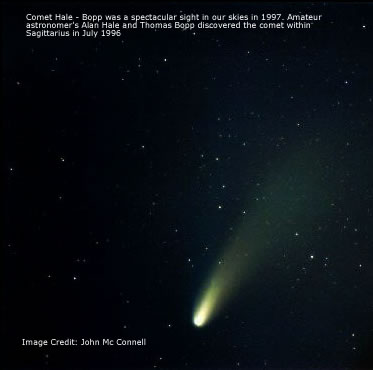 |
The heavens appeared on fire, flamming torches traversed in all directions the depths of space; a comet, that fearful star which overthrows the powers of the Earth, showed its horrid hair. Seneca's nephew If at your coming princes disappear, comets! come every day - and stay a year. Sammuel Johnson Letter to Mrs Thrale (6 October 1783). Comets are like cats - they have tails and do precisely what they want. David H. Levy
|
Stalking Cometary Prey
Visual comet hunting is the systematic search for new comets by the visual amateur astronomer using the naked eye, binoculars or telescope. It is a way of exploring the night sky on a one to one basis were the searcher checks each moving field of view (FOV) of his or her instrument in the hope of discovering that faint misty patch of light of an unknown comet first beginning to shine. Comet hunting is a discipline, a way of observing the sky like no other as the sky will decide what you might see compared to the conventional approach were the observer is in charge, here you are the watchman but it's the sky that is in charge! This unpredictable nature of the chase is what lures many into this exciting field of observing. Comet hunting will teach you the sky in a manner you will never forget and a part from the comets themselves you will be in for at least several treats...
1) You will be reacquainted with many of the Messier objects on a regular basis.
2) You will sweep up countless objects from the New General Catalogue and Index catalogue that you never knew your scope could detect.
3) You will notice the passage of many telescopic satellites, occasionally three or more in the same field.
4) You will be treated to the sudden appearance of telescopic meteors which often do not coincide with the major showers.
5) You will be astounded at the rich star fields you encounter while scanning though the milky way.
6) You may even be lucky enough to sweep up a known comet which will give you an unforgettable thrill and prove that your comet hunting method is sound. Your known comet may even be in the process of a major outburst in magnitude and if this is the case then you should report your discovery to the appropriate authorities and promptly!
Comet Seeking Equipment
Although any kind of telescope can be used for comet hunting I heartily recommend a short focal length instrument. These kinds of telescope will give you a much larger FOV with a given eyepiece hence increasing the contrast between faint nebulous objects and the background sky, also you will see a wider area of sky in one look which will provide you with the opportunity to patrol larger sectors of the sky in a shorter period of time compared with a long focal length instrument. Alt - azimuth mounts are a favourite choice as they let you sweep the sky in a more comfortable and natural fashion. Equatorial mounts tend not to be user friendly for visual hunting due to the polar axis blocking the all important polar regions however do not despair as you can off - set your EQ mount to get at this area and with practice it will become second nature. Newtonian reflectors are the favoured choice by many comet hunters as they provide a relatively high contrast large field for a reasonable price. The small to medium aperture reflectors tend to be more successful at bagging the bright twilight comets where as the larger 'light buckets' are the preferred tool for hunting down fainter cometary quarry farther from the sun. Some successful comet discoverer's use a variety of instruments for this very reason.
Scope Suggestions
I would suggest using a 6" to 8" short focus reflector on an alt - azimuth mount with an eyepiece that will give you a FOV of at least 45 minutes of arc however the eyepiece / scope combination delivering a field of 1 degree or more would be desirable. I use an 8" F/6.3 SCT at 49X and a 16" F/4.5 Dobsonian Reflector at 57X. The larger scope delivers a field greater than two full moon diameters however your choice of eyepiece will determine just how large a field you can get but watch out for the effects of vignetting. I also use 8" and 10" F/7 homemade dobsonians. If you are eager to start comet hunting but you feel your scope is not suitable do not worry...far more important than the type of telescope used for comet hunting is the dedication of its user, a scope sitting in your room is not going to find any comets!
Search Areas
Since comets brighten as they approach the sun the best place to find a new comet is within the sun's vicinity. The region of sky within 90 degrees elongation of the sun outlines your visual patrol area, this large slowly changing sky sector is known as the 'comet haystack region'. Searching beyond this zone is certainly not counter productive however does require larger apertures to go deeper as comets located this far from the sun tend to be fainter than magnitude 12 and are unlikely to be picked up by a visual sweep however comets are unpredictable and there are exceptions to every rule. A number of bright comets can and have been discovered far from the sun and high in the sky outside typical search regions although they are few and far between but at the end of the day it will come down to how much time you can devote to these areas, however the main reason to skirt these high solar elongation areas is because this is the playground of the large professional telescopic CCD surveys such as LINEAR, NEAT, LONEOS, SPACEWATCH, CSS and PANSTARRS etc. To avoid these tireless prolific NEO surveys you need to concentrate your search to the sky close around the sun where even these big surveys dare not tread. Concentrate on the horizon below the pole and if you can search below - 30 degrees in declination then you will have an increased chance of success. Searching the twilight regions as the sky darkens with the naked eye or binoculars is a worth while pursuit as you could pick up a bright comet that is cloaked in the suns glare. The telescopic search can begin when the sky is still bright, start your hunt through the twilight areas near the horizon which will soon drop from view. As long as you can see stars to magnitude 4 with the naked eye then it is suitable to undertake a comet hunting pass through a sky sector of your choice. Gradually as the sky darkens you can work your way in to the higher sky regions and into less fertile hunting ground. I recommend between 1
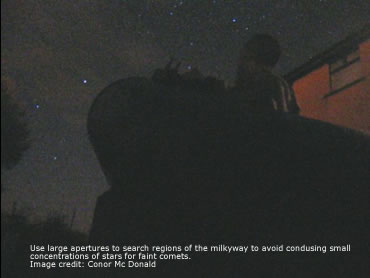 |
and 3 hours of sweeping in the evening sky and the same again in the morning sky before dawn. The eastern sky in the morning twilight should be your main area of focus as statistically four times as many comets are found in the morning sky compared to the corresponding dusk regions. Also bear in mind that fewer observers are active at this unsociable hour of the night especially during the week when many will find it difficult to rise from a snug warm bed in the heart of winter so by taking advantage of this time slot you could increase your chances of success while cutting down on the world wide competition although many will find this requires extreme discipline and drive to fit into their daily routine and work load. The morning sky should get just as much if not more of your attention than your evening vigil. |
Search Times
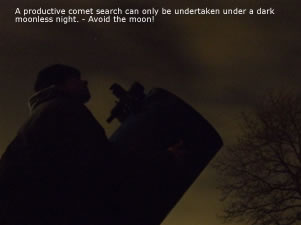 |
You should undertake your search for comets only under a dark sky, this means becoming intimate with the moons cycle and phases. If the moon is at first quarter phase or greater then the chances of making a comet discovery become so small that your observing time would be better spent in other areas of astronomy. Finding the moon rise / set times from your latitude is easy using a variety of web sites or desktop software like 'Starry Night Pro'. The best time to begin your evening comet sweep is when the moon is about two days after full. When this happens the sky that was once bathed in strong moonlight is suddenly thrust into darkness for 1 - 2 hours before the moon again rises above the eastern horizon. With each consecutive evening the waning moon will rise later as it moves along its easterly course through the ecliptic providing you with more and more hours of darkness. These slowly growing dark 'window' periods are a |
very important and competitive time as a bright new comet could have suddenly appeared in the sky hidden from view by bright lunar glare and is suddenly thrust into visibility for all to see when the early dark period arrives with a new comet waiting to be discovered by anyone looking in that area!
The next prime search time on the comet seekers monthly calendar is just before a new moon in the morning sky when the waning moon is not bright enough to hinder faint telescopic targets. I usually begin my own pre dawn hunt 1 - 2 days after last quarter phase. This is the best time of the night as already mentioned above.
Patterns Of Search
Comet sweeping can be done in either a horizontal or vertical motion depending on your own tastes and mount configuration. With my 8" Sct I use a horizontal sweeping pattern as I find it easy and more comfortable to use from a seated position however with the 16" Dobsonian I tend to use a vertical sweeping pattern partly because my telescope moves better in altitude and is less stressful on my back. Research completed by the Japanese has shown that the human eye is more efficient at detecting faint objects using vertical motion!
The Comet Suspects
Sooner or later you will stumble across a fuzzy object in the night sky that will trigger a burst of adrenaline...could that be a comet? probably not however it will be a comet suspect until you can identify its true nature. These fuzzy non stellar objects are hidden all over the sky, David Levy called them 'highway men guilty of stopping comet hunters in there search'. You will come to know these objects well within the first few years of your search programme and for most of that time you will be identifying and familiarizing yourself with them which is a delightful experience in itself. When I first encountered these deep sky objects consisting of galaxies, nebulae, star clusters and supernova remnants I sketched the objects visual profile in my low power eyepiece, made notes on its physical description, cross checked them with a good star atlas and recorded this data in my observing log book. Eventually with several hundred hours experience you will gradually built a profound knowledge of these objects in your head and will rarely need to consult a star atlas for reference. Identifying the nature of an elusive deep sky object 'on sight' from memory is a very satisfying and enriching experience!!
You Are Pointing Here! - A Good Finder Scope
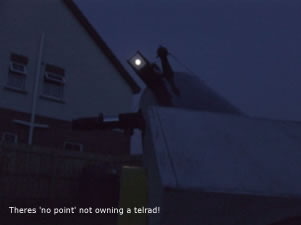 |
In addition to a good 8X50 mm or 9X50 mm finder scope located at a user friendly position near the eyepiece you should also attach the extremely popular 1x type reflex finders currently on the market such as the 'Telrad', 'Rigel Quick Finder' etc. These amazing devices project an illuminated red bulls eye onto a clear glass plate against the starry background as it appears with the naked eye. Once aligned with your scope (very easy to do even in the dark) the small red circle / dot at the centre guided on a star or planet will guarantee the said object is at the centre of your FOV aiding you greatly when you need to know where in the sky your scope is pointing helping you easily identify the position of a faint galaxy in the night sky that is invisible to the naked eye. An inexpensive dew heater can be purchased or made which will keep your telrad dew and frost free for hours at a time. |
To aid me in the identification process I always have a copy of Sky Atlas 2000.0 (field edition) which serves me well. It contains all of the suspects an 8" telescope can find under a dark sky. Other publications like Uranometria 2000 or the Millennium star atlas go even deeper. Compliment any of these works with desktop software such as 'Starry Night Pro' and internet access will provide you with an impressive arsenal for separating comet suspects from the real thing.
The Creep
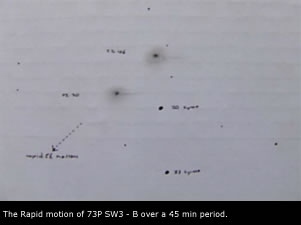 |
You have just gone through your sky atlas and used up your online resources which have shown nothing when clearly there is something in your telescope so what should you do next? There is but one golden rule that separates would be comets from real comets - they move! All comets creep across the starry background and this speed will depend upon the comets proximity to the earth or sun. Sketch the suspect in relation to the fixed background stars through a medium or higher power eyepiece, look back again in 15 minutes - has it moved? if not then wait longer. All comets do show motion eventually so if dawn is approaching or the object is setting then check it again the following night. If it has not moved during this period then chances are that you have bagged a faint galaxy or nebula that you have somehow overlooked...wasn't it exciting though? |
A good example of comet motion in recent times was the spectacular break up of 73P/Schwassmann - Wachmann 3. In May 2006 backyard observers using binoculars and small telescopes on the bright fragments C and B could actually see the comet moving in near 'real time' due to the comet trains close passage by the earth. Comets much further from the sun will not reveal their motion so easily - patience is the name of the game.
Living Within The Deep Sky
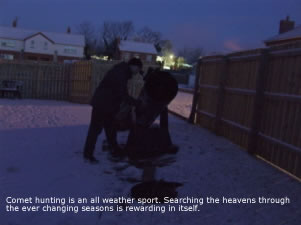 |
To find a cometary needle in the haystack you need to know what comets DO NOT look like. You need to become a master of the deep sky getting yourself aquatinted with the subtle visual appearance and wide variety of non stellar objects. Galaxies are symmetrical and tend to have sharp edges along with the smaller planetary nebulae which can look almost stellar. The majority of globular clusters have a mottled texture and exhibit bright cores whereas comets have a soft, diffuse profile that often makes it difficult to tell where the coma ends and the sky begins. The more obvious diffuse / reflection nebulae give away their identity due to their irregular chaotic shape however the fainter nebulae lit from behind by a background star in the form of tiny wisps and puffs of light can cause |
some uncertainty such as 'Hubble's Variable Nebula' and NGC1931 in Auriga. The majority of galaxies are easy to identify by their shapes due to their orientation in space from our line of sight here on earth however any galaxy whose surface brightness is barely brighter than the background sky will need to be double checked. David Levy suggests that you do not begin a serious comet hunt until you have located and described as many of the Messier objects as you can.
Your confidence has grown as you sail through the realm of galaxies and clusters but now we need to set sail into the uncharted territory of the comets. The plan sounds simple enough - observe all the comets you can find with your telescope. Tracking down, observing and following a selection of known comets that appear in all parts of the sky, in ever changing sky conditions and at all times of the night spread out over the seasons will provide you with the trained eye and discipline that is needed for a successful comet search. Now you are ready, you have done your part....the rest is up to the sky. All you need now is a comet!
Got One! - What Should I Do Next?
Your heart is pumping, your adrenalin is flowing, your mind is ambushed by fleeting bursts of thought and confusing emotions, you have just discovered a new comet!!! you dreamed about and rehearsed this moment hundreds of times in your mind but now you find yourself frozen to the spot (or else jumping on the spot) without a notion of what to do next. Take a deep breath and collect yourself for these next few moments will be critical.
1) Do not be tempted to rush inside and report your suspected find immediately. Are you 100% certain you detected obvious motion? double check one more time.
2) Are you sure the comet nesting in your star field is a new one? double check the positions of all the known comets in the sky using the online comet resources just to be sure. If you cannot get access to the internet then phone a friend as I am sure they would be delighted to play a part in the discovery process. Make sure you check the positions of comets that are fainter than what your own telescope can show incase one of these comets has undergone an outburst. If this is the case then send a report to the relevant authorities.
If you are sure you have a new comet that may be a secret to the rest of the world then you need to note the following information..
* The double date and time in UT (Universal Time) or your own time zone if you are not sure.
* Estimate the comets magnitude as best you can using suitable comparison stars in the area.
* How large is the coma?
* How condensed or diffuse is the overall comet, rate a D.C (degree of condensation) value.
* Provide a written physical description of the comet remarking on the coma's shape / colour, tail length and P.A if there is one.
* Mark as accurately as you can the comets RA and DEC (epoch 2000) and its direction and rate of motion. Or simply supply two positions in RA and DEC separated by time.
* If possible get a second observer of high reputation to confirm your discovery either visually or on a digital image.
Send an email with the above information including your name and address as the discoverer to the Central Bureau Of Astronomical Telegrams (CBAT) followed by a back up second email. If your discovery report gets confirmation from the IAU then the comet will be named after you unless others have also found it. You are also likely to receive a financial reward via the Edgar Wilson reward. Congratulations!
Comet Comments
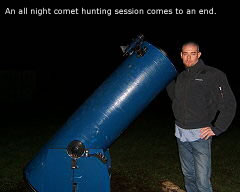 |
There is an interesting statistic which states that one must search for an average of 400 hours for a first comet discovery and 200 hours for each subsequent find. In the previous decade this statistic was very accurate although the results did vary wildly from observer to observer. Donald Machholz spent 1700 hours for his first comet and a further 1700 hours for his second, David Levy had logged 917 hours at the eyepiece for his first. Since the advent of the professional survey telescopes I feel the 400 hour average no longer applies. I would expect visual searchers sweeping for well beyond 1000 hours will be the norm. However do not be discouraged, Mark Whitaker aged 14 began searching for comets for a summer project and discovered a new comet on his second night using a 4" reflector! |
The legendary George Alcock got his name on the tails of five comets, he even found two in five days, one of which he spotted while observing through the window of his house while wearing his pajamas!
If you are serious about comet hunting then you will need to be in it for the long run. Searching for a minimum of one hour every clear dark night is essential, Donald Machholz recommends spending at least 100 hours a year with the time equally divided between the evening and morning sky. Attitude is important, do not be tempted to rush quickly through the sky giving each field a casual glance, take your time and examine each star field carefully using averted vision, after all this is a relaxing and fun way of observing. Always overlap fields and search areas and search a small section of the sky thoroughly rather than a large area haphazardly. You will find that your comet hunting will be more productive using this approach. Repeat your evening and morning sweeps at least twice each dark period to increase your chances of spotting a faint comet that may have experienced a short lived outburst.
To date I have logged over 900 hours of comet hunting spread over a six year period and will continue to do so. The next great comet could be discovered tonight so you never know what the future holds. I wish you the very best of luck with your search...Happy Hunting
Martin McKenna